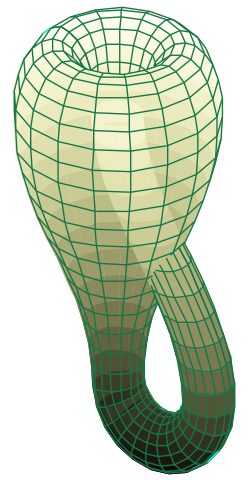
Thanks to Alice for the image. <3
I’ve actually seen Cinerama, real Cinerama, at one of the few places left on Earth that’s got the synchronized projectors, the skilled technicians, and an actual Cinerama print to show. The three-screen Cinerama process was expensive. The machinery was finicky. The logistics pretty fierce. As a result, Cinerama never really caught on, despite the splendors of movies like How The West Was Won. But if you travel to Bradford and get to the museum on the right day, you can see what all the fuss was about. And you can join in the continuing celebration.
What I’m witnessing as we begin the third week of the New Media Faculty Development Seminar leaves Cinerama, breathtaking and beautiful as it is, in the dust. (And I don’t say that idly–I loved This Is Cinerama when I saw it in Bradford in 2000.)

I’m not going to be able to knit my thoughts into anything very elegant or polished. I’m feeling rather awestruck by the network, by the beautiful patterns of response emerging from it on a daily basis. The most obvious place to see those patterns is the Netvibes portal, one great place to get the comprehensive view of the activity generated by the network (and the network generated by the activity).
But the portal is only one of the wonders. Another is that the every node in the network, seen with the digital imagination, is also potentially a great place to get the comprehensive view. I wish I had superitalics to stress this point even more emphatically. The fractal, network-of-networks model doesn’t just follow a paradigm in which sets of unitary-simple-examples aggregate into a highly complex set-of-sets that retains features of each set and each element in each set. It does something far more rich and strange.
Let me try to explain. You know babushkas? Here’s a picture from the Wikipedia article:

Women amid the flowers
This design is pretty easy to understand, and accords well with our sense that in the physical world, small things go inside bigger things. That’s the key to the Maggie Sort Algorithm, too:
What I’m seeing in the Networked Seminar, however, is more like a Klein Bottle:

Eine Kleine Klein Bottle
which Wikipedia defines as
a non-orientable surface, informally, a surface (a two-dimensional manifold) with no identifiable “inner” and “outer” sides. Other related non-orientable objects include the Möbius strip and the real projective plane. Whereas a Möbius strip is a two-dimensional surface with boundary, a Klein bottle has no boundary. (For comparison, a sphere is an orientable surface with no boundary.)
It’s fair to say that I have little idea what all that means, but “little” does not equal “no,” and the metaphor intrigues me (always has) for the same reason Moebius strips intrigue me, but more so, because the Klein Bottle lets me talk about objects in which the inside is bigger than the outside.
Which is really the point I want to get across here. The networked seminar is not, or not just, a set of nested self-similar iterations of the same idea, though that’s certainly the easiest and most direct mental picture of the initial design. The difference between the babushkas and the networked seminar is that any given point in this augmented human network, one may find that the inner or “smaller” nodes are actually every bit as large as the complete aggregation, and in many cases even larger. As near as I can tell, that’s because every single brain, every single embodied instance of personhood, every single blog post with its language of words and images and sounds and concept structures, can link freely to itself, to other posts in the person’s blog, to other blogs within each local group, to blogs at other local groups, to the portal itself, and of course to the other people represented and enacted by these things, which means that every post can be a kind of portalesque motherblog, and every motherblog can be thought of as a single post, and every person is potentially the entire networked seminar, and any link as well as the entire aggregation can be held in a single thought. I can see this happening in ways that are deeply interesting, even spooky.
Let’s go with spooky.
Last Wednesday I facilitated the Baylor seminar’s discussion of Vannevar Bush’s “As We May Think.” I talked about blogging as a particular genre of, instantiation of, metaphor for, the Memex, particularly with the ways hyperlinks, including the trackbacks they can generate when blogs are linked, are examples of “associative trails.” I thought I’d not spent quite enough time on the essay itself, and too much time on the mechanics of blogging. But then, to my delight, the integration I was trying to get at actually happened over the past week, across multiple levels, because the blogs started coming in across the network in earnest. In fact, folks in our Baylor seminar are all now blogging, and many are now blogging with posts full of links (hyper- and semantic, and is there a difference?) to other blogs. One such blog elicited a comment with its own playful links, which must qualify as some kind of link-jazz.
Further, last week a blogger at the Monterey Institute of International Studies quoted a blogger at the Baylor site. Obviously the MIIS blogger was reading the portal feed, or moving across the motherblogs by means of the networked seminar directory. Ah! And though the link was a quote and not a hyperlink (see how the notion of “link” moves from concept to procedure and back again), I caught the link myself because I had also been scanning the blog feeds on the portal, and when I read the MIIS blogger’s post I had recognized the quotation (made the connection mentally, so formed/recognized the link). (I confess: when I saw the title was “Nuggets,” I *had* to go take a look. Witness, dear reader, the value of the evocative title.) Now, having incorporated those links into this post, I have folded the mental links and hyperlinks into the entire set of (implicit and explicit) associative trails (and scaffolding) that the blogs are producing within and across all the sites.
Um, whoa.
Then an even spookier thing happened.
Thursday I had the great privilege of facilitating the discussion on Bush’s essay via a Skype connection with the group Tom Haymes is leading at Houston Community College. It was a great discussion, very passionate and insightful, and I found myself quite inspired by it all. Friday, I was scanning the blog feeds to read the HCC blogs about the discussion. Then I clicked over to some of the other sites’ blogs to see what was happening there. Oops! I was brought up short. I thought I’d clicked on a St. Lawrence University blog post. It sure looked like their site. But as I read the post, it was clear to me something had gone wrong. I was reading a description of the discussion at HCC, which had included very thoughtful inquiries into the relationship of information, knowledge, and wisdom. Then I realized that in fact I was reading a description of the HCC discussion–because that’s what they’d talked about at St. Lawrence University as well.
And now my links bear witness to that connection, tell my story of those connections, and enact them anew.
This property of the link–that it is both map and territory–is one I’ve blogged about before (a lucky blog for me, as it elicited three of my Favorite Comments Ever). But now I see something much larger coming into view. Each person enacts the network. At the same time, the network begins to represent and enact the infinities within the persons who make it up. The inside is bigger than the outside. Each part contains the whole, and also contributes to the whole.
Bush’s idea of folded-in-associative-trails gets at this phenomenon, though he doesn’t explore it as fully as I’d like. For me, this folding-within, up and down the scale until scale itself acquires paradoxical meanings, is where the going gets really, really good. I mean quantum good. I also think it’s where Engelbart begins to build his conceptual framework, which for me is a framework about how the inside is bigger than the outside–among many other things, of course. But I’ll save those many other things for the next NMFS blog.
Oh, and here’s the lagniappe. My friend and colleague Tim Logan has a great idea for an NMFS visualization project. I’m going to need some expert help on this one. Tim’s idea is to construct a dynamic map of the thought-connections among the network nodes. I suggested trackbacks (i.e., incoming links) and comments as proxies for these connections. Now all we need is some way to gather the comments-and-trackbacks and have the map automagically trace/draw the connections within and among the sites. Anyone have any ideas for how to do that?

Here’s my own whoa: I *just* learned what lagniappe meant this past weekend, and voila, it shows up in your post!
Pingback: Tweets that mention Seven Wonders, Vannevar Bush, and NMFS_F10 « Gardner Writes -- Topsy.com
Pingback: Automatic transmissions and manual steering on the information superhighway « Jon Udell
Pingback: Automatic shifting and manual steering on the information superhighway « Jon Udell